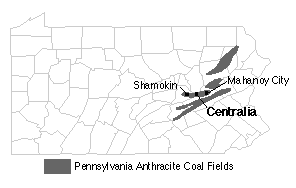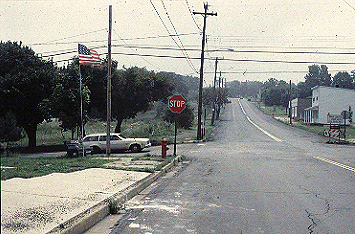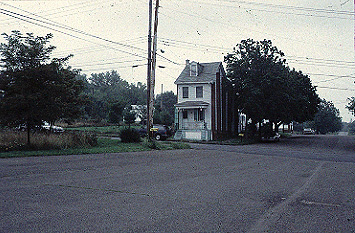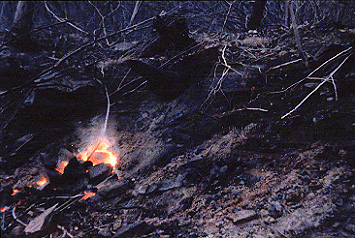


Place Taste and the Taste of Place:
Centralia,
Pennsylvania.
Published in Globehead! The Journal of Extreme Geography (Volume 1: Thing 2, 1995)
updated 11/6/01
text and photos copyright 1999 j.b. krygier
One enters the anthracite coal regions of south-eastern Pennsylvania from rich
agricultural valleys, green with well-tended crops and ornamented with the
occasional Amish buggy and farmstead. Such wholesome quaintness contrasts nicely
with the convulsed and moldering coalscapes of the Western-Middle anthracite
region, stretching from Shamokin in the west to Mahanoy City in the east. Upon
entering Shamokin on Pennsylvania highway 61, one is confronted by an immense
ridge of culm - mining waste - looming over the highway and the town, black and
rusted red, speckled with birch trees. Shamokin is similar to many towns in the
anthracite region, worn down, with a crumbling infrastructure, an underoccupied
business district, Polish workingmen's clubs, many churches, more cemeteries, and
tight ribbons of houses full of people who still sit on porches. There are many
people, many more than one would expect considering the coal mining which turned
this valley inside out has all but ceased.

Anthracite Coal in Pennsylvania.
Traveling east on highway 61 one encounters piles, piles, and more piles. A landscape of piles - coal, culm, old machinery, collapsed collieries, collections of old mattresses and toilets and roofing shingles dumped by the roadside - everywhere piles. Then orange, dead streams, more towns and more people. And the aberrant, discordant landscape. It is all to easy to condemn the Philadelphia capitalists who colonized these coal valleys, removed its wealth as their own and left the landscape as a brazen monument to their deeds. Yet there is an odd attraction to such landscapes, maybe even a strange, incongruent beauty. Dead places occupied by life (people everywhere), jagged, torn earth and comatose machines slowly being enveloped by a shroud of vivid vegetation, curious and refreshing eccentricity mixed with awareness of relentless and unfettered exploitation; a duplicitous landscape.

Downtown Centralia, PA.
Centralia, near the heart of the Western-Middle anthracite region, appears suddenly, striking in change from the piles and rubblescapes which precede it along highway 61. The familiar grid street pattern, sidewalks, curbs, a municipal bench to sit on, and large curb-side trees which betray the age of the town. Then, driveways and walks up to...empty lots. Some mowed, some planted with wildflowers. But, oddly, no houses. Then a few houses. Row houses, narrow and tall. Actually a single row house, divorced from its long-time neighbors and necessarily propped up with red brick buttresses. A fire smolders in the abandoned mines under Centralia. Most of the 1400 Centralians, after years of protracted conflict with state and federal agencies and each other, have left, their homes purchased and demolished by the federal government, converted into piles somewhere else.

Single row house, propped. Centralia, PA.
The sulfury smellscape of Centralia grows more insistent as one nears the "hot" part of town, where the fire is closest to the surface. A church near a field of pipes venting noxious gasses - and further stoking the fire - sits near the southern edge of town. Beyond this the gentle curve of highway 61 (this stretch closed to traffic) slopes through a broad, rumpled, smoking field, well-baked dead trees bleached white and charred at their bases. One stands on the buckled asphalt road and watches this curious, roasted landscape...but not for long. The road is hot through your shoes. Moving onto the spongy, burnt field from the road you must step around small holes venting fumes from far below. A taste of soil from near one of these vent holes betrays some sense of the place: a complex, slight sulfury burnt flavor with a metallic overtone, fine and dusty in consistency. Surprisingly moist and organic, it quickly coats your mouth with an inky pervasiveness. Repeated spitting never quite expels the blackness, and the taste remains in your mouth as Centralia remains in your mind.

The burn, Centralia, PA.
Centralia is duplicity in a duplicitous landscape. A town that really isn't a town, yet someone repairs and maintains the roads and sidewalks, and a post office and a location on the state road map are retained. A town with solitary "row" houses and empty lots filled with wildflowers simmering over a malodorous fire. A town which ended up in turmoil, half the Centralians wanting to get paid and get out and half wanting to stay. A town where death threats and tire slashings and fire bombings peppered the debate over whether to preserve the "community." A town where state and federal engineers, bureaucrats, and politicians bumbled and dug holes and sunk test pits and declared the place safe and declared the place dangerous and confused themselves and the Centralians. Above all, the taste of Centralia is much as Centralia is: sulfury, burnt, and sparse, dense with organic material, once alive but now dead, seemingly fertile but damned by what burns below.
For more information on Centralia
...see these books:
David DeKok. Unseen danger : A Tragedy of People, Government, and the Centralia Mine Fire. Philadelphia : University of Pennsylvania Press, 1986.
- Book available at Amazon.com and BarnesandNoble.com
J. Stephen Kroll-Smith and Stephen Robert Couch. The Real Disaster is Above Ground : A Mine Fire & Social Conflict. Lexington, Ky. : University Press of Kentucky, 1990.
...or online, check out these WWW sites:
...and on the Pennsylvania Anthracite Region in general...
E-mail: jbkrygie@cc.owu.edu